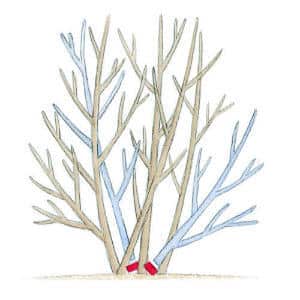Winter Pruning Guide
There aren’t many things you can do for your garden in the winter, besides the planning and daydreaming that goes on indoors. Pruning is one great task that can be done in the winter to help the enjoyment of your garden the rest of the season. Pruning isn’t something that needs to be done and certainly not every season. I chose to prune when it will add to the beauty in the garden or landscape. Most of the pruning I do is corrective in the early years of a new landscape to shape some new plants for future aesthetic or to restore some old shrubs that have become overgrown or have been sheared into one shape for many years. My point is- you don’t HAVE to prune. Look to doing it if you have a shrub that is overgrown, has dense growth on the outside of the plant or could use a little beatifying in its woody structure. Technically speaking pruning is done to take some energy away from unneeded or unwanted parts of the shrub and redistribute that energy for flowering or fruit production later.
Here are the plants that can be pruned at this time of year. If we are in a particularly cold winter you can wait a little longer and prune in early March.
Good to prune right now- go for it!
Abelia, Arborvitae, beautyberry, boxwood, butterfly bush, chastetree, cherry laurel, Clethera, Cotoneaster, crape myrtle, redtwig dogwood, Eleagnus (this one is invasive, so cut it back to the ground and plant something else!), Euonymus (aggressive), Hibiscus, Gardenia, Deciduous holly, summer blooming Hydrangea, St John’s Wort, Hypericum, juniper, Nandina, Osmanthus, Photinia, privet-cut this one down all the way to the ground (this is my hint at removing privet from your garden entirely, snark snark), Potentilla, smoke tree, summer blooming spirea and yew.
How do I prune?
If you’ve established that you have one of the above listed plants and you would like to prune, first determine if you are doing the following:
1. Pruning the whole plant way back because it is too large– this can be done with the thought in mind that you may lose the plant (though this has rarely happened in my experience). This is for something that is so dang large and out of control. You are desperate and are tempted to get rid of it entirely, but you also don’t want to spend cash on a new plant. Cut it way back. It may grow back smaller and really nice- bonus! If not, take it out and get a new one!
2. Thinning the plant because the foliage is too thick and not much light gets into the middle of the plant. In this sort of pruning you want to take entire branches out selectively to open up the light getting through to the center. If it is a larger shrub and has been overgrow for a long time then I would remove 1/3 of the branches now and then do the same next year and the following. That way the plant is not losing a large amount at once. I’ve used this method in restoring lilacs, viburnums and many other larger, older flowering shrubs.
3. Restoring the plant to a more natural growth habit- This is what you do when the shrub has been sheared into a shape for many years and you would like to stop being a slave to your pruning shears.
In this sort of pruning you will want to prune out branches that cross over one another, thin out branches where there are too many and generally remove about 1/3 of the outer growth of the plant.
Now that you know what you are pruning and what type of pruning you are doing make sure you select some good tools. You’ll want to use lopers and pruning saws for larger and woody branches and hand pruners for smaller branches. Make sure your blades are newly sharpened and your tools are oiled and tightened properly. You want to make a good clean cut close to the crotch of the branch but not cutting in to the main stem and make cuts just above new buds.
How to Avoid Pruning
Select plants which already have a desirable growth habit with no crossing branches or odd shaping. Take a step back and look at the branching habit of the plant before you buy it.
Select the proper plant for the proper location. If you put something that is going to grow 6 ft in a 3 ft space you will be pruning a lot!
Be comfortable with the natural growth habit of the plants you select.
Save energy, save time, save money!

